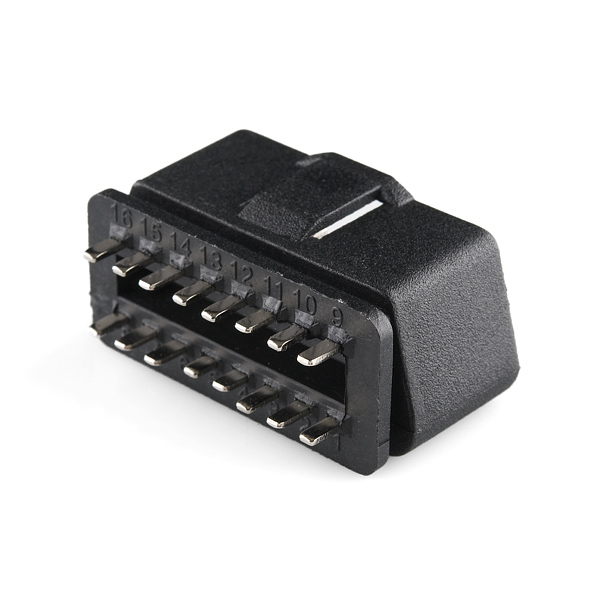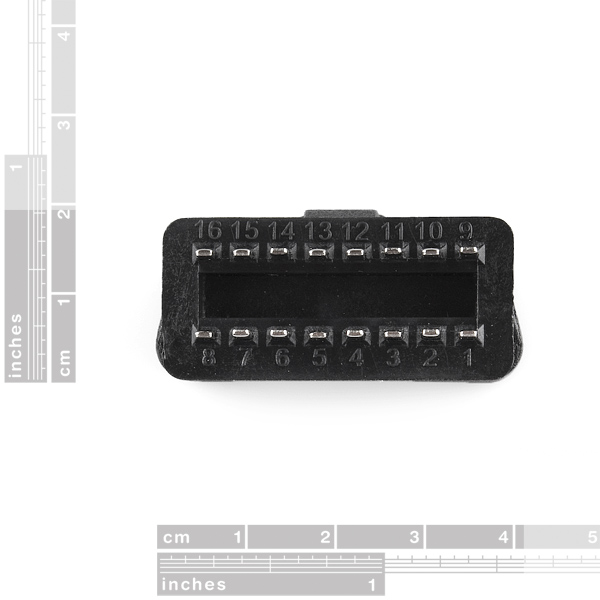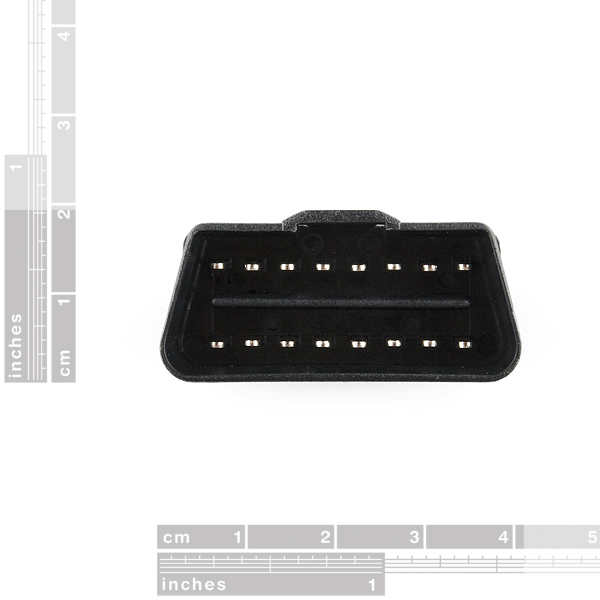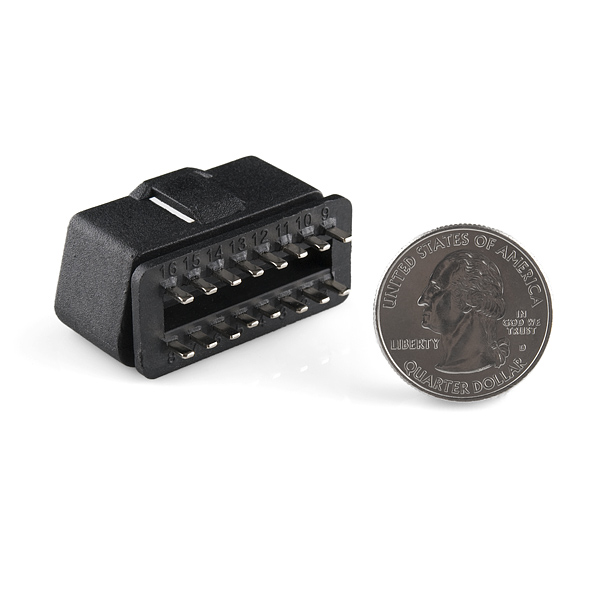OBDII is an on board diagnostics standard that is used on a large variety of cars. OBD-II provides access to numerous data from the engine control unit (ECU) and offers a valuable source of information when troubleshooting problems inside a vehicle. If you're not sure if your car works with OBDII you can look under your dash, the connector is generally located below your dash on the driver side. This is great if you want to try to build your own diagnostic reader.
OBD-II Connector Product Help and Resources
Getting Started with OBD-II
October 8, 2015
A general guide to the OBD-II protocols used for communication in automotive and industrial applications.
Core Skill: Soldering
This skill defines how difficult the soldering is on a particular product. It might be a couple simple solder joints, or require special reflow tools.
Skill Level: Noob - Some basic soldering is required, but it is limited to a just a few pins, basic through-hole soldering, and couple (if any) polarized components. A basic soldering iron is all you should need.
See all skill levels
Comments
Looking for answers to technical questions?
We welcome your comments and suggestions below. However, if you are looking for solutions to technical questions please see our Technical Assistance page.
Customer Reviews
3.7 out of 5
Based on 3 ratings:
2 of 2 found this helpful:
Fits perfectly
Tested it on a Ford Fiesta 2014. I was able to access data on the CAN bus without any issues.
Does not fit
The male pins are too wide to fit in a standard OBDII port. I am measuring the pin width at 1.8mm while a commercial OBDII scanner has 1.5mm pins.
The female pin ports are measuring up between 1.7mm and 1.8mm.
This port needs more slop! It is designed for 200lb gorillas to be blindly plugging in and tearing out daily. A press fit is not ideal.
I was able to get it to fit into my 2009 Suburu Impreza and I'm a 136lb 5'7" male human. It might be that you got a connector that is on the upper edges of the tolerances of the component.
If you would like, you can contact Techsupport@sparkfun.com and I am sure they can work out an exchange for you if you would like.
Fit Pefectly, Feels durable
Have tested in 4 different makes and models so far and has fit each one perfectly, the part itself feels very sturdy and durable, pins were easy to solder and didn't melt the housing during the process. So far so good...





If someone if looking for a female connector, is this one right ? Female OBD2 Connector
Do you have a mechanical drawing for this connector? I'd like to try to build a small board that fits directly on the connector housing.
Self-contained OBD-II module:
http://www.scantool.net/microobd-200.html
This is an OBDII scanner that I made.
http://www.youtube.com/watch?v=pYwoqfysGJA
It uses the ELM327, a PIC and a MAX7456 for video.
I am currently working on a version with a 2.8" LCD with touchscreen.
Single T: We would love to make an OBDII dev board, it's just a matter of getting an Engineer to build one. Hopefully that will be the next step after the basic breakout is released.
pay me for my time and I will develop one :)
I've found that the OBDII plugs I've used have been very tight and require a lot of force to plug and unplug. I'd be concerned about breaking a PC board when unplugging it. I think I'd rather have a cable with a nice strong plug on the end to keep the stress away from the board. But I do like having something like this available. It opens up a lot of possibilities...
Agreed, however, we have tested this on a Ford, Jeep, Audi, VW, Toyota, and Nissan. It fit nicely into all but the Audi, VW. The first proto of the breakout is a little tight on those 2 makes. We are working on a solution before releasing anything.
Thanks
ELM327 OBDII WiFi Wireless Diagnostic Scanner For Apple IPhone Touch http://www.obd2works.com/elm327-obdii-wifi-wireless-diagnostic-scanner-for-apple-iphone-touch-p-1527.html
I'e designed a few OBDII adapters using this connector and the RN-42 module Sparkfun sells (used to be the BTM-182). You can connect to the adapter via Bluetooth. There are STN1110 and ELM327 versions available complete w/ gerbers and Altium source.
Check them out here: OBD-II Bluetooth Adapters The adapters are open source and hackable!
Nevermind, I found it in the library :)
Is there a strain relief part for this connector? I can't imagine a sturdy way to connect a cable to those lugs...
Answered my own question: I'll get one of these[Suntek?] instead, and just use a DB9 connector on the remote PCB.
We are planning a breakout board that you could solder directly to. The DB9 version looks nice though.
Is this cable:
http://www.sparkfun.com/commerce/product_info.php?products_id=10087
your version of the proposed breakout board? I think that it's a better solution (as long as cable length isn't a limiting factor for any of your busses) because I've worked as a salesperson at Advance Auto Parts, and plugged scanners into many cars' OBDII ports, and it would be very difficult to make a breakout compatible with everything. The cable puts it right where you need it - In the passengers' hands, or the center console.
I am glad that you carry it, as I haven't done business with Suntek before and would prefer just adding yours to my next order :) Thanks!
You guys should make an OBDII development board with an ATMega1280 (running the Arduino bootloader) connected to the ELM327, an IC with firmware that can send, receive, or listen to OBD commands of any type.
I tried making a schematic for this at one point, but I'm no good at Eagle. It would be pretty cool because it would allow you to make custom gauges, dataloggers, etc. that not only can read data from the car, but would be able to send arbitrary commands to the car as well. Or is this a liability? You decide.
Check out this interesting read on the security of the CAN bus in most modern cars (or the complete lack thereof). It's quite a read, especially the fact that you can compile arbitrary code and run it in the RAM of any of the car's ECUs if you really wanted to.
http://www.autosec.org/pubs/cars-oakland2010.pdf
We would love to make an OBDII dev board, it's just a matter of getting an Engineer to build one. Hopefully that will be the next step after the basic breakout is released.
Our company (ScanTool.net) just finished designing a small form factor OBD module in a DIP-24 package, and a development board to go along with it. Product brief and sample schematics (including development board schematics) can be found here:
http://www.scantool.net/microobd-200.html
We plan to release the EAGLE files for the dev board once we test the Rev B protos.
A variety of OBD cables are available from www.obd2cables.com. One trick you can use to make the connector fit better over the DLC, is heat it up with a blowdryer just prior to plugging it in.
Vitaliy
The ELM 347 is limiting. This should be mated with the Atmel chip that does CAN.
The protocols can be easily done - reading J1850 over the IC3 pin (or the read (I'm doing it now), the ISO9141/14230 are UARTs with a few extra waves, and there's CAN.
(BTW - my main job is doing diagnostic equipment for cars so I know OBD, and the ETI extensions and J2534).
The best thing would be a breakout with space for or the actual drivers for each of the protocols. They usually aren't standard and hard to duplicate with discrete components.